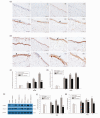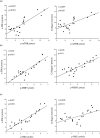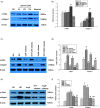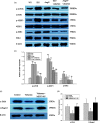Valsartan ameliorates high glucose-induced peritoneal fibrosis by blocking mTORC1 signaling
- PMID: 32408765
- PMCID: PMC7427179
- DOI: 10.1177/1535370220919364
Valsartan ameliorates high glucose-induced peritoneal fibrosis by blocking mTORC1 signaling
Abstract
Our study provided new insight into the mechanism underlying the preservation of the peritoneum by valsartan. The results demonstrated that the mice receiving chronic high glucose (HG) peritoneal dialysis solution infusion showed a typical feature of peritoneal fibrosis (PF), as well as higher expression of α-smooth muscle actin (α-SMA) and collagen I. In vitro, HG increased the protein expression of α-SMA and collagen I in a dose-dependent manner, while valsartan significantly ameliorated these pathological changes. Interestingly, there was a parallel decrease in the activity of mammalian target of rapamycin complex 1 (mTORC1) and the protein expression levels of α-SMA and collagen I upon treatment with valsartan in vivo and in vitro. Moreover, the mTOR agonist MHY1485 reversed the downregulation of α-SMA and collagen I in vitro, even in the presence of valsartan. Altogether, our findings reported for the first time that valsartan exerts a protective effect against HG-induced PF by inhibiting the activity of the mTORC1 pathway.
Keywords: Valsartan; extracellular matrix accumulation; high-glucose peritoneal dialysis solution; human peritoneal mesothelial cell; mammalian target of rapamycin complex 1; peritoneal fibrosis.
Figures







Similar articles
-
Mammalian Target of Rapamycin Complex 1 Activation Disrupts the Low-Density Lipoprotein Receptor Pathway: A Novel Mechanism for Extracellular Matrix Accumulation in Human Peritoneal Mesothelial Cells.Am J Nephrol. 2018;48(5):357-368. doi: 10.1159/000494144. Epub 2018 Nov 13. Am J Nephrol. 2018. PMID: 30423569
-
Activation of the RAS contributes to peritoneal fibrosis via dysregulation of low-density lipoprotein receptor.Am J Physiol Renal Physiol. 2021 Mar 1;320(3):F273-F284. doi: 10.1152/ajprenal.00149.2020. Epub 2021 Jan 11. Am J Physiol Renal Physiol. 2021. PMID: 33427062
-
Empagliflozin, a sodium glucose cotransporter-2 inhibitor, ameliorates peritoneal fibrosis via suppressing TGF-β/Smad signaling.Int Immunopharmacol. 2021 Apr;93:107374. doi: 10.1016/j.intimp.2021.107374. Epub 2021 Jan 29. Int Immunopharmacol. 2021. PMID: 33517222
-
Preventing peritoneal membrane fibrosis in peritoneal dialysis patients.Kidney Int. 2016 Sep;90(3):515-24. doi: 10.1016/j.kint.2016.03.040. Epub 2016 Jun 7. Kidney Int. 2016. PMID: 27282936 Review.
-
Encapsulating Peritoneal Sclerosis.Semin Nephrol. 2017 Jan;37(1):93-102. doi: 10.1016/j.semnephrol.2016.10.010. Semin Nephrol. 2017. PMID: 28153198 Review.
Cited by
-
Metabolic reprogramming of peritoneal mesothelial cells in peritoneal dialysis-associated fibrosis: therapeutic targets and strategies.Cell Commun Signal. 2025 Feb 27;23(1):114. doi: 10.1186/s12964-025-02113-2. Cell Commun Signal. 2025. PMID: 40016825 Free PMC article. Review.
-
Integrative analysis of chromatin accessibility and transcriptome landscapes in the induction of peritoneal fibrosis by high glucose.J Transl Med. 2024 Mar 5;22(1):243. doi: 10.1186/s12967-024-05037-6. J Transl Med. 2024. PMID: 38443979 Free PMC article.
-
LCZ696, an angiotensin receptor-neprilysin inhibitor, ameliorates epithelial-mesenchymal transition of peritoneal mesothelial cells and M2 macrophage polarization.Ren Fail. 2024 Dec;46(2):2392849. doi: 10.1080/0886022X.2024.2392849. Epub 2024 Aug 21. Ren Fail. 2024. PMID: 39165231 Free PMC article.
References
-
- Zhang Z, Jiang N, Ni Z. Strategies for preventing peritoneal fibrosis in peritoneal dialysis patients: new insights based on peritoneal inflammation and angiogenesis. Front Med 2017; 11:349–58 - PubMed
-
- Zhou Q, Bajo MA, Del Peso G, Yu X, Selgas R. Preventing peritoneal membrane fibrosis in peritoneal dialysis patients. Kidney Int 2016; 90:515–24 - PubMed
-
- Sun X, Wei W, Ren J, Liang Y, Wang M, Gui Y, Xue X, Li J, Dai C. Inhibition of 4E-BP1 phosphorylation promotes tubular cell escaping from G2/M arrest and ameliorates kidney fibrosis. Cell Signal 2019; 62:109331. - PubMed
-
- Woodcock HV, Eley JD, Guillotin D, Plate M, Nanthakumar CB, Martufi M, Peace S, Joberty G, Poeckel D, Good RB, Taylor AR, Zinn N, Redding M, Forty EJ, Hynds RE, Swanton C, Karsdal M, Maher TM, Bergamini G, Marshall RP, Blanchard AD, Mercer PF, Chambers RC. The mTORC1/4E-BP1 axis represents a critical signaling node during fibrogenesis. Nat Commun 2019; 10:6. - PMC - PubMed
Publication types
MeSH terms
Substances
LinkOut - more resources
Full Text Sources
Miscellaneous

